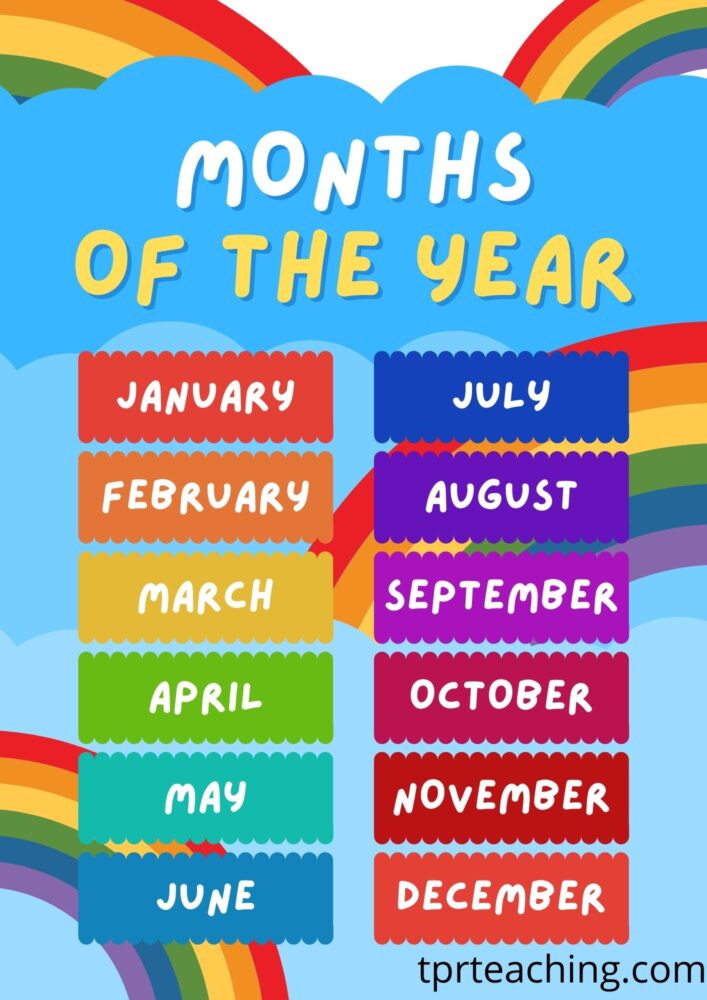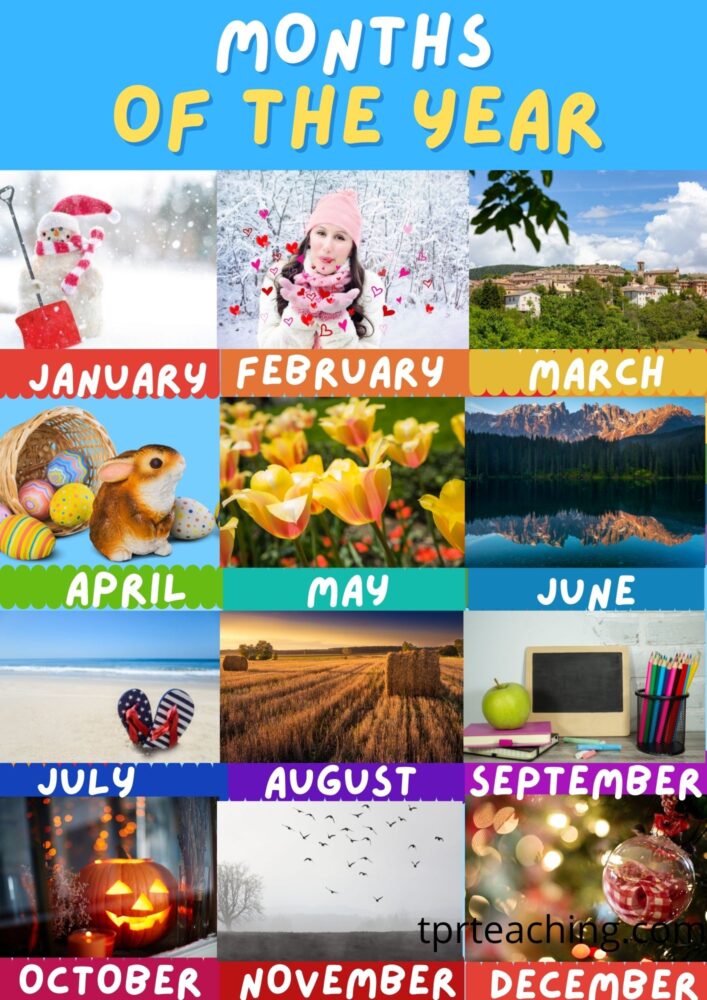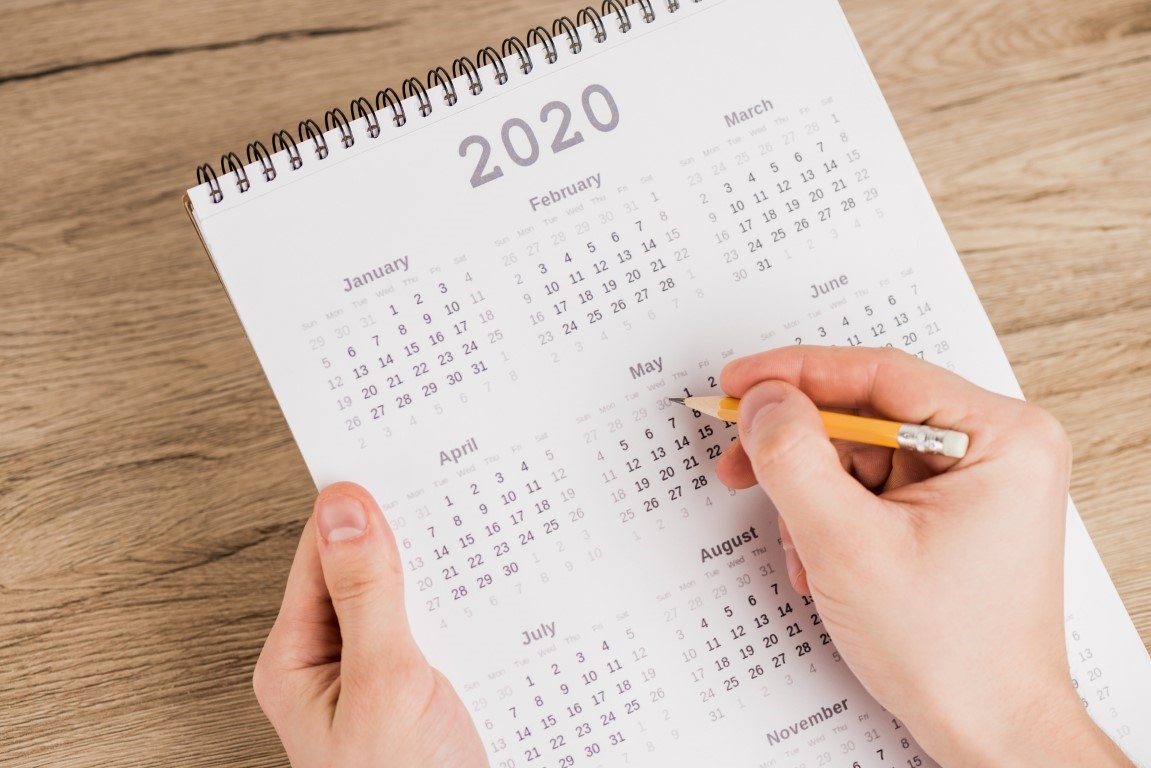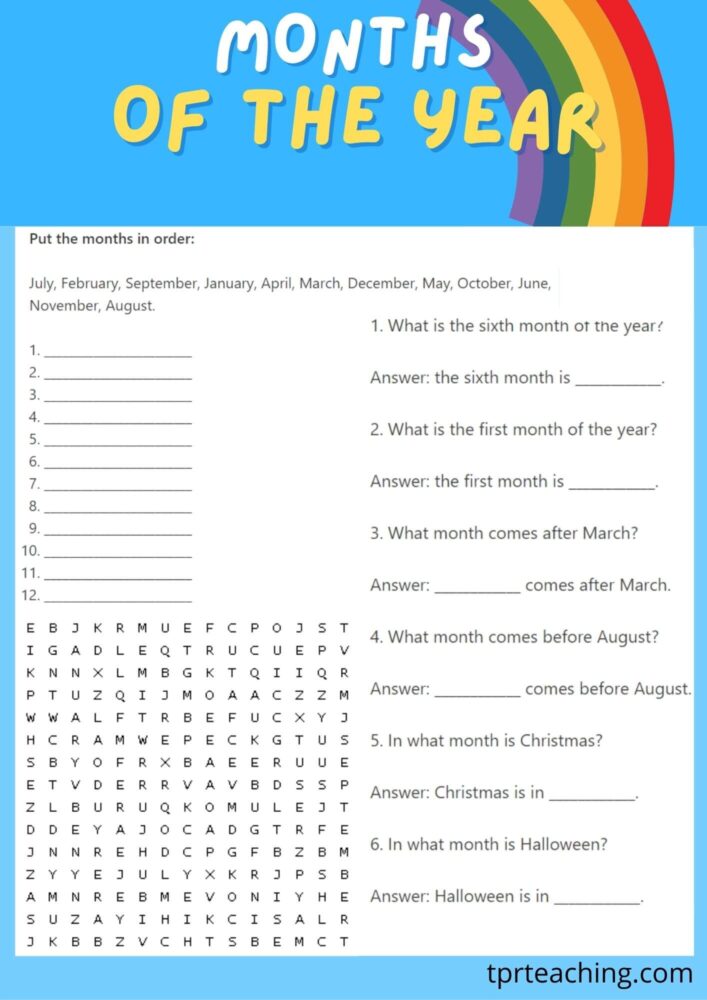There are twelve months of the year in the English calendar.
The names of these months, when written in full, are as follows: January, February, March, April, May, June, July, August, September, October, November, and December.

What are the months of the year?
Here are the months of the year in order:
| Month | Short Form | Days | Season | |
| 1. | January | Jan. | 31 | winter |
| 2. | February | Feb. | 28/29 | winter |
| 3. | March | Mar. | 31 | spring |
| 4. | April | Apr. | 30 | spring |
| 5. | May | May | 31 | spring |
| 6. | June | Jun. | 30 | summer |
| 7. | July | Jul. | 31 | summer |
| 8. | August | Aug. | 31 | summer |
| 9. | September | Sep. | 30 | autumn |
| 10. | October | Oct. | 31 | autumn |
| 11. | November | Nov. | 30 | autumn |
| 12. | December | Dec. | 31 | winter |
What is a month?
A month is a unit of time in many calendar systems, such as the Gregorian and Islamic calendars.
The word month is derived from the old English word mōnaþ and comes from the Proto-Germanic word for “moon.” This is because the Moon takes 29.5 days to travel around the Earth, and this approximately matches up to a calendar month.
The traditional concept is that a month is a period between two successive syzygies (new moons).
There are twelve months in a year. January is the first month of the year, and December is the last one.
How many days in a month?
A month is a unit of time. It contains an average of about four weeks in the Gregorian calendar system.
Each month has a different number of days. The shortest month is February which has 28 or 29 days, while the longest one is July which has 31 days.
There are 12 months in one year. All months have thirty or thirty-one days except February, which has 28 days every year. This number changes only if there is a leap year (every four years) when February will end up with 29 days.
How to Learn the Months of the Year
Here are some tips to follow to help you learn the months of the year.
- Practice singing songs with the months of the year. You can find many on Youtube such as this one:
- Practice writing and saying the months of the year. Here are some exercises to get you started:
Put the months in order:
July, February, September, January, April, March, December, May, October, June, November, August.
- ________________________
- ________________________
- ________________________
- ________________________
- ________________________
- ________________________
- ________________________
- ________________________
- ________________________
- ________________________
- ________________________
- ________________________
Find the months of the year in the Wordsearch:

1. What is the sixth month of the year?
Answer: the sixth month is ____________.
2. What is the first month of the year?
Answer: the first month is ____________.
3. What month comes after March?
Answer: ____________ comes after March.
4. What month comes before August?
Answer: ____________ comes before August.
5. In what month is Christmas?
Answer: Christmas is in ____________.
6. In what month is Halloween?
Answer: Halloween is in ____________.
7. When is your birthday?
Answer: My birthday is in ____________.
Answers:
- June
- January
- April
- July
- December
- October
- (Birthday Month)
Months That Have 30 Days
- April
- June
- September
- November
Months That Have 31 Days
- January
- March
- May
- July
- August
- December
Exception: February
February has 28 days, but 29 days in a leap year. A leap year occurs every four years and there are 366 days in a leap year.
Examples of Sentences with the Months of the Year
- March comes after January in the calendar.
- The fourth month of the year is April.
- My holiday is in August.
- October is my favorite month because that’s when Halloween happens!
- I’ll be having my birthday in December this year, on December 10th.
- Today is October 31st, 2020.
- The month of February has only 28 days because there is no leap year.
- I returned to school in September last year.
- The President of the United States arrived in Ireland in July 2020.
Grammar of the Months in English
The months can be written in their short form (Jan, Feb, etc.), but other abbreviations are also correct, for example, Ja, Fe, Ma, or J., F., M.
The first letter of a month is capitalized as a proper noun. Similarly, holidays and the days of the week are capitalized no matter where they appear in the sentence.
There are no differences between American and British English spellings of the months.
When writing dates in English, it is written as the day-month-year in British English but the month-day-year in American English.
Examples (American English)
- 11/21/2012
- November 4th
- January 23rd, 2016
- January 23, 2016
- June the fifth, 2009
Examples (British English)
- 21/11/2012
- 4th November
- 23rd January 2016
- 23 January 2016
- The second of December

You may also be interested in: 15 Best Online English Courses Free & Paid (2022)
Origin of the Months of the Year
Where did the months of the year come from? How did it all begin? Let’s look at the story behind each month of the year.
January
Janus was a Roman god of beginnings and endings who had two faces.
Janus ruled over doors and gates, which seems relevant to the beginning of a new year.
He is frequently represented with two faces: one looking ahead and the other looking behind.
January was the final month to be incorporated into the calendar, which initially had ten months and started in March.
February
February is named for a Roman purification holiday known as februa, which occurred around February 15.
Februa means “month of cleansing,” and February was formerly the final month of the year.
A “month of cleansing” appears to be a wonderful approach to say goodbye to the old and welcome in the new.
March
The month of March is named after the Roman god of war called Mars.
The period between the old and new year was used to declare a truce in ancient Rome because March was originally the first month.
After all, it was warm enough to resume fighting.
April
According to one theory, April takes its name from the Latin word for “second,” as it is the second month of the year.
However, others claim that April derives its name from the Latin term apereire, which means “to open,” suggesting springtime.
It’s also said to have been named after Aphrodite, the Greek goddess of love and beauty.
May
The month of May comes from the Greek goddess Maia. She was the Roman goddess of Earth and Springtime.
June
Juno, queen of the Roman gods, was named after June.
Juno was associated with childbirth and marriage, which is appropriate for one of the most popular months for weddings.
July
The month of July was named after Julius Caesar, who was born in the month.
Previously, July was known as “Quintilis,” which meant “fifth” and referred to the fact that July was the fifth month with the calendar year beginning in March.
The month of July was also the first to be named for an actual individual rather than a Roman or Greek deity.
August
August is named after Augustus Caesar, the first emperor of ancient Rome.
August was previously called “Sextilius,” which means “sixth.”
Emperor Augustus’ legacy eventually gave rise to the term august, which refers to “respected and impressive.”
September, October, November, December
The Latin terms septem, octo, novem, and decem, meaning “seventh,” “eighth,” “ninth,” and “tenth,” give us the English words September, October, November, and December.
While this no longer applies to the calendar year, they were indeed previously the seventh, eighth, ninth, and tenth months.

Commonly Asked Questions
Other questions related to the months of the year:
How many days in a year?
There are 365 days in one year. If it is a leap year, there are 366 days. A leap year occurs every four years.
What is a leap year?
A Leap Year has 366 days. There is an extra day added to the last month of the year, February, every four years due to the different cycles involved with Earth’s rotation. This extra day is known as a ‘leap day.’ 2016, 2020 and 2024 are leap years.
That concludes the months of the year for English-speaking countries.
Other Links You Might Find Useful
- What Are Vowels and Consonants? The Difference
- How Many Letters Are In The Alphabet?
- 30 Examples of Verbs in Sentences
- Color Names List in English with Pictures (36 Colors!)
Caitriona Maria is an education writer and founder of TPR Teaching, crafting inspiring pieces that promote the importance of developing new skills. For 7 years, she has been committed to providing students with the best learning opportunities possible, both domestically and abroad. Dedicated to unlocking students' potential, Caitriona has taught English in several countries and continues to explore new cultures through her travels.


